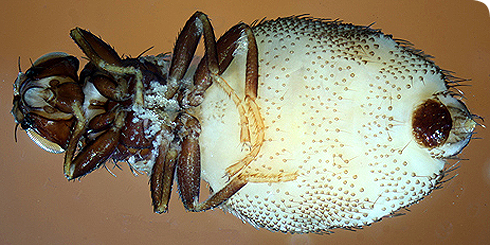Biology
Lifecycle
The lifecycle comprises of
- adult stage
- 3 larval phases
- encompassing around 21 days at 22ºC and 95% relative humidity
- pupal stage
After a diapause usually lasting several months (Guigan et al. 1983) flies emerge the following spring at the time after nesting sites have been reoccupied by birds, thus allowing the perpetuation of Carnus in the nest (Valera et al. 2006). After its eclosion, the adult is initially winged and capable of flying, but typically loses its wings once it locates a suitable hosts (Walter & Hudde 1987, Dawson & Bortolotti 1997, Grimaldi 1997, Papp & Darvas 1998).
Adults are short-lived (less than 2 days, Valera et al. 2006) and copulations take place on the hosts (Guigan et al 1983, Valera et al. 2006). The abdomen of the females distends greatly when the eggs are produced. The eggs are laid in the nest and the larvae feed on organic materials in the nest and overwinter as pupae.
Because neither the adults nor the larvae have been found on adult birds, flies are assumed to colonize nest hosts actively during the winged phase of their life cycle (Grimaldi 1997, Roulin 1998, 1999).
The occurence of the flies is correlated with the breeding season of the birds. For example in Spain adult Carnus hemapterus flies emerged from the fourth week of May until the first week of July with a peak in the second week of June (Valera et al. 2003).
The normal infestation on starling nestlings is 19 flies per brood with the maximum being about 144 on a brood of five seven day old nestlings (Walter & Hudde 1987). On Common Barn-Owl nestlings the mean infestation was 17 flies per infested owl (Kirkpatrick & Colvin 1989). The infestation drops when the nestlings start to molt from down to flight feathers (Kirkpatrick & Colvin 1989, Dawson & Bortolotti 1997).
Mosts nests contain a mixture of infested and uninfested nestlings. Within nests, the avarage relative mass of infested chicks was greater than that of uninfested chicks. In normal cases being parasitized by Carnus does not seem to have a negative effect on the host (Dawson & Bortolotti 1997).
There is one record of an adult Carnus hemapterus fly found in the ear of a human (Iwasa et al 2000).
